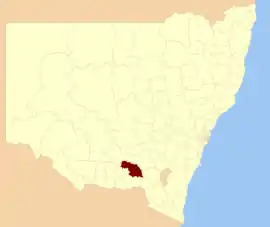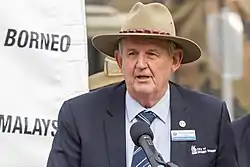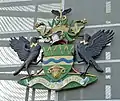City of Wagga Wagga
City of Wagga Wagga is a local government area in the Riverina region of south-western New South Wales, Australia.
| Wagga Wagga New South Wales | |||||||||||||||
|---|---|---|---|---|---|---|---|---|---|---|---|---|---|---|---|
 | |||||||||||||||
| Coordinates | 35°08′S 147°22′E | ||||||||||||||
| Population | |||||||||||||||
| • Density | 12.92712/km2 (33.4811/sq mi) | ||||||||||||||
| Established | 15 March 1870 (Borough)[3] 17 April 1946 (City)[4] | ||||||||||||||
| Area | 4,825.9 km2 (1,863.3 sq mi)[5] | ||||||||||||||
| Mayor | Greg Conkey[6] | ||||||||||||||
| Council seat | Wagga Wagga[7] | ||||||||||||||
| Region | Riverina | ||||||||||||||
| State electorate(s) | Wagga Wagga | ||||||||||||||
| Federal Division(s) | Riverina | ||||||||||||||
 | |||||||||||||||
| Website | Wagga Wagga | ||||||||||||||
| |||||||||||||||
The Mayor of the City of Wagga Wagga is Cr. Greg Conkey, an independent politician.[6]
City, town and localities
The City of Wagga Wagga includes the suburbs of
History
Wagga Wagga was first incorporated as the Borough of Wagga Wagga on 15 March 1870.[8] It received city status and became the City of Wagga Wagga on 17 April 1946. The municipality enlarged substantially on 1 January 1981 when the adjoining Shire of Kyeamba and Shire of Mitchell were amalgamated into the City.[9]
Heritage listings
The City of Wagga Wagga has a number of heritage-listed sites, including:
- Bomen, Main Southern railway: Bomen railway station[10]
- Tarcutta, Tarcutta Street: Hambledon Homestead[11]
- Wagga Wagga, Botanic Gardens Site (BGS), Baden Powell Drive: Mobile Cook's Galley, Museum of the Riverina[12]
- Wagga Wagga, Main Southern railway: Wagga Wagga railway station[13]
Demographics
At the 2016 census, there were 62,385 people in the City of Wagga Wagga local government area, of these 48.9 per cent were male and 51.1 per cent were female. Aboriginal and Torres Strait Islander people made up 5.6 per cent of the population, which was twice the national and average of 2.9 per cent. The median age of people in the City of Wagga Wagga was 35 years, which was lower than the national median of 38 years. Children aged 0 – 14 years made up 20.3 per cent of the population and people aged 65 years and over made up 15.2 per cent of the population. Of people in the area aged 15 years and over, 46.6 per cent were married and 11.4 per cent were either divorced or separated.[1]
Population growth in the Tamworth Regional Council between the 2011 census and the 2016 census was 4.92 per cent. When compared with total population growth of Australia for the same period, being 8.8 per cent, population growth in the City of Wagga Wagga local government area was around half of the national average.[1] The median weekly income of $1,354 within the City of Wagga Wagga local government area was slightly lower than the national average of $1,438.[1]
At the 2016 census, the proportion of residents in the Tamworth Regional local government area who stated their ancestry as Australian or Anglo-Saxon exceeded 80 per cent of all residents (national average was around 60 per cent). Approximately two-thirds (67%) of all residents in the City of Wagga Wagga nominated a religious affiliation with Christianity at the 2016 census, which was higher than the national average of approximately 60 per cent. Meanwhile, as at the census date, compared to the national average, households in the City of Wagga Wagga local government area had a significantly lower than average proportion (7.6 per cent) where two or more languages are spoken (national average was 26.4 per cent); and a significantly higher proportion (87.8 per cent) where English only was spoken at home (national average was 68.5 per cent).[1]
| Selected historical census data for the City of Wagga Wagga local government area | ||||||
|---|---|---|---|---|---|---|
| Census year | 2001 | 2006[14] | 2011[15] | 2016[1] | ||
| Population | Estimated residents on Census night | 54,845 | 57,015 | |||
| LGA rank in terms of size within New South Wales | 39th | |||||
| % of New South Wales population | 0.87% | |||||
| % of Australian population | 0.29% | |||||
| Cultural and language diversity | ||||||
| Ancestry, top responses | Australian | 34.3% | ||||
| English | 29.2% | |||||
| Irish | 10.4% | |||||
| Scottish | 7.6% | |||||
| German | 4.1% | |||||
| Language, top responses (other than English) | Malayalam | 0.6% | ||||
| Arabic | ||||||
| Mandarin | 0.4% | |||||
| Filipino | 0.3% | |||||
| Tagalog | 0.3% | |||||
| Religious affiliation | ||||||
| Religious affiliation, top responses | Catholic | 33.2% | ||||
| No Religion | 15.0% | |||||
| Anglican | 23.9% | |||||
| Presbyterian and Reformed | 6.2% | |||||
| Uniting Church | 6.3% | 5.5% | ||||
| Median weekly incomes | ||||||
| Personal income | Median weekly personal income | A$586 | A$696 | |||
| % of Australian median income | ||||||
| Family income | Median weekly family income | A$1,418 | A$1,682 | |||
| % of Australian median income | ||||||
| Household income | Median weekly household income | A$1,149 | A$1,354 | |||
| % of Australian median income | ||||||
Council


Current composition and election method
Wagga Wagga City Council (WWCC)[16] is composed of nine Councillors elected proportionally as a single ward. All Councillors are elected for a fixed four-year term of office. The Mayor is elected by the Councillors at the first meeting of the Council. The most recent election was held on 10 September 2016, and the makeup of the Council is as follows:[17]
| Party | Councillors | |
|---|---|---|
| Independents and Unaligned | 7 | |
| Labor Party | 2 | |
| Total | 9 | |
The current Council, elected in 2016, in order of election, is:[17]
| Councillor | Party | Notes | |
|---|---|---|---|
| Greg Conkey | Independent | Mayor[18] | |
| Dan Hayes | Labor | ||
| Kerry Pascoe | Independent | ||
| Paul Funnell | Independent | ||
| Tim Koschel | Independent | ||
| Yvonne Braid | Independent | ||
| Rod Kendall | Independent | ||
| Vanessa Keenan | Labor | ||
| Dallas Tout | Independent | Deputy Mayor | |
A referendum was held on 8 September 2012 and an absolute majority of voters resolved in favour to reduce the number of Councillors from eleven to nine.[19] The change came into effect at the September 2016 elections.
Administration staff
In December 2009, Wagga Wagga City Council announced that it had appointed Phil Pinyon as the General Manager of the Wagga Wagga City Council replacing Lyn Russell, who suddenly announced her resignation in October 2009, after completing 18 months of her five-year contract.[20][21][22]
Symbols and emblems
The floral emblem for the city is the Silver Banksia.[23]
Gallery
 Wagga Wagga Civic Centre
Wagga Wagga Civic Centre Wagga Wagga Coat of Arms
Wagga Wagga Coat of Arms City Council Mayoral gong. Stolen 2 January 2009, remains unfound
City Council Mayoral gong. Stolen 2 January 2009, remains unfound
See also
References
- Australian Bureau of Statistics (27 June 2017). "Wagga Wagga (C) (Local Government Area)". 2016 Census QuickStats. Retrieved 27 June 2017.

- "3218.0 – Regional Population Growth, Australia, 2017-18". Australian Bureau of Statistics. 27 March 2019. Retrieved 27 March 2019. Estimated resident population (ERP) at 30 June 2018.
- "Government Gazette Proclamations and Legislation". New South Wales Government Gazette (60). New South Wales, Australia. 15 March 1870. p. 642. Retrieved 9 September 2018 – via National Library of Australia.
- "LOCAL GOVERNMENT ACT, 1919.—PROCLAMATION". Government Gazette of the State of New South Wales (43). New South Wales, Australia. 26 April 1946. p. 997. Retrieved 9 September 2018 – via National Library of Australia.
- "3218.0 – Regional Population Growth, Australia, 2012". Australian Bureau of Statistics. 30 August 2013. Retrieved 27 March 2014. Estimated resident population (ERP) at 30 June 2012.
- "Wagga has a new mayor". The Daily Advertiser. 25 September 2012. Retrieved 25 September 2012.
- "Wagga Wagga City Council". Department of Local Government. Archived from the original on 7 September 2006. Retrieved 30 November 2006.
- "Government Gazette Proclamations and Legislation". New South Wales Government Gazette (60). New South Wales, Australia. 15 March 1870. p. 641. Retrieved 9 September 2018 – via National Library of Australia.
- "Municipality of Wagga Wagga, New South Wales". Museum Victoria. Retrieved 9 September 2018.
- "Bomen Railway Station". New South Wales State Heritage Register. Office of Environment and Heritage. H01093. Retrieved 18 May 2018.
- "Hambledon Homestead". New South Wales State Heritage Register. Office of Environment and Heritage. H00351. Retrieved 18 May 2018.
- "Mobile Cook's Galley, Museum of the Riverina". New South Wales State Heritage Register. Office of Environment and Heritage. H01722. Retrieved 18 May 2018.
- "Wagga Wagga Railway Station and yard group". New South Wales State Heritage Register. Office of Environment and Heritage. H01279. Retrieved 18 May 2018.
- Australian Bureau of Statistics (25 October 2007). "Wagga Wagga (C)". 2006 Census QuickStats. Retrieved 24 November 2017.
- Australian Bureau of Statistics (31 October 2012). "Wagga Wagga (C)". 2011 Census QuickStats. Retrieved 24 November 2017.

- http://www.abc.net.au/news/2015-11-18/preparations-underway-for-syrian-refugee-arrivals/6950144
- "Wagga Wagga City Council: Summary of First Preference and Group Votes for each Candidate". Local Government Elections 2016. Electoral Commission of New South Wales. 16 September 2016. Retrieved 17 September 2016.
- "Councillors". City of Wagga Wagga. Retrieved 9 October 2018.
- "Wagga Wagga City Council – Referendum". Local Government Elections 2012. Electoral Commission of New South Wales. 14 September 2012. Retrieved 1 October 2012.
- "Wagga council GM quits". ABC News. Australia. 5 October 2009. Retrieved 3 October 2012.
- "New Wagga council GM looks to the future". ABC Riverina NSW. Australia. 4 April 2008. Retrieved 8 April 2008.
- "New CEO gets straight to it". The Daily Advertiser. 1 April 2008. Retrieved 8 April 2008.
- "Water Wise and Salt Tolerant Plants" (PDF). Wagga Wagga City Council. Archived from the original (PDF) on 1 October 2009. Retrieved 8 April 2008.
External links
 Media related to City of Wagga Wagga at Wikimedia Commons
Media related to City of Wagga Wagga at Wikimedia Commons- Wagga Wagga City Council website